
Concept explainers
Draw the structure corresponding to each name.
(a)
(b)
(c)
(d)
(e) potassium acetate
(f) sodium
(g)
(h)
(a)
Interpretation: The structure corresponding to the given name is to be stated.
Concept introduction: International Union of Pure and Applied Chemistry gave guidelines to write the chemical name of molecules. There are three steps to derive the structure of the compound from its IUPAC name. The first step involves the identification of the parent name and the functional group found at the end of the name. The second step is numbering of carbon skeleton in either direction. The third step is the addition of substituents at appropriate carbon atoms.
Answer to Problem 19.30P
The structure corresponding to
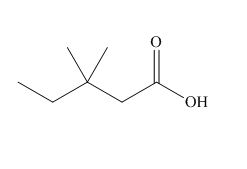
Explanation of Solution
The name of the compound is

Figure 1
The structure of
(b)
Interpretation: The structure corresponding to the given name is to be stated.
Concept introduction: International Union of Pure and Applied Chemistry gave guidelines to write the chemical name of molecules. There are three steps to derive the structure of the compound from its IUPAC name. The first step involves the identification of the parent name and the functional group found at the end of the name. The second step is numbering of carbon skeleton in either direction. The third step is the addition of substituents at appropriate carbon atoms.
Answer to Problem 19.30P
The structure corresponding to
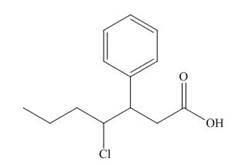
Explanation of Solution
The name of the compound is

Figure 2
The structure of
(c)
Interpretation: The structure corresponding to the given name is to be stated.
Concept introduction: International Union of Pure and Applied Chemistry gave guidelines to write the chemical name of molecules. There are three steps to derive the structure of the compound from its IUPAC name. The first step involves the identification of the parent name and the functional group found at the end of the name. The second step is numbering of carbon skeleton in either direction. The third step is the addition of substituents at appropriate carbon atoms.
Answer to Problem 19.30P
The structure corresponding to
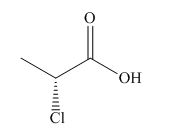
Explanation of Solution
The name of the compound is
The stereochemistry of the compound is determined by prioritizing the groups attached to its stereogenic center. The groups are prioritized on the basis of atomic number of their atoms. The configuration of the compound is
Therefore, the structure corresponding to the given name is,

Figure 3
The structure of
(d)
Interpretation: The structure corresponding to given name is to be stated.
Concept introduction: International Union of Pure and Applied Chemistry gave guidelines to write the chemical name of molecules. There are three steps to derive the structure of the compound from its IUPAC name. The first step involves the identification of the parent name and the functional group found at the end of the name. The second step is numbering of carbon skeleton in either direction. The third step is the addition of substituents at appropriate carbon atoms.
Answer to Problem 19.30P
The structure corresponding to
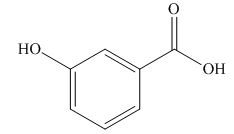
Explanation of Solution
The name of the compound is

Figure 4
The structure of
(e)
Interpretation: The structure corresponding to the given name is to be stated.
Concept introduction: International Union of Pure and Applied Chemistry gave guidelines to write the chemical name of molecules. There are three steps to derive the structure of the compound from its IUPAC name. The first step involves the identification of the parent name and the functional group found at the end of the name. The second step is numbering of carbon skeleton in either direction. The third step is the addition of substituents at appropriate carbon atoms.
Answer to Problem 19.30P
The structure corresponding to potassium acetate is,
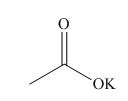
Explanation of Solution
The name of the compound is potassium acetate. The name suggests that potassium is present in the place of hydrogen in acetic acid. Therefore, the structure corresponding to the given name is,

Figure 5
The structure of potassium acetate is drawn in Figure 5.
(f)
Interpretation: The structure corresponding to the given name is to be stated.
Concept introduction: International Union of Pure and Applied Chemistry gave guidelines to write the chemical name of molecules. There are three steps to derive the structure of the compound from its IUPAC name. The first step involves the identification of the parent name and the functional group found at the end of the name. The second step is numbering of carbon skeleton in either direction. The third step is the addition of substituents at appropriate carbon atoms.
Answer to Problem 19.30P
The structure corresponding to sodium
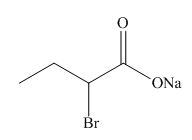
Explanation of Solution
The name of the compound is sodium

Figure 6
The structure of sodium
(g)
Interpretation: The structure corresponding to the given name is to be stated.
Concept introduction: International Union of Pure and Applied Chemistry gave guidelines to write the chemical name of molecules. There are three steps to derive the structure of the compound from its IUPAC name. The first step involves the identification of the parent name and the functional group found at the end of the name. The second step is numbering of carbon skeleton in either direction. The third step is the addition of substituents at appropriate carbon atoms.
Answer to Problem 19.30P
The structure corresponding to
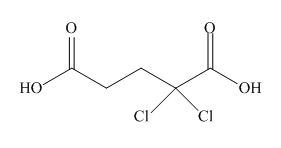
Explanation of Solution
The name of the compound is

Figure 7
The structure of
(h)
Interpretation: The structure corresponding to the given name is to be stated.
Concept introduction: International Union of Pure and Applied Chemistry gave guidelines to write the chemical name of molecules. There are three steps to derive the structure of the compound from its IUPAC name. The first step involves the identification of the parent name and the functional group found at the end of the name. The second step is numbering of carbon skeleton in either direction. The third step is the addition of substituents at appropriate carbon atoms.
Answer to Problem 19.30P
The structure corresponding to
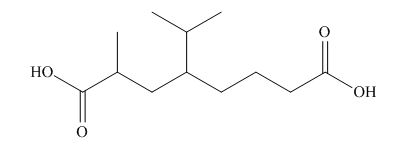
Explanation of Solution
The name of the compound is

Figure 8
The structure of
Want to see more full solutions like this?
Chapter 19 Solutions
PKG ORGANIC CHEMISTRY
- QUESTION: Find the standard deviation for the 4 different groups 5.298 3.977 223.4 148.7 5.38 4.24 353.7 278.2 5.033 4.044 334.6 268.7 4.706 3.621 305.6 234.4 4.816 3.728 340.0 262.7 4.828 4.496 304.3 283.2 4.993 3.865 244.7 143.6 STDEV = STDEV = STDEV = STDEV =arrow_forwardQUESTION: Fill in the answers in the empty green boxes regarding 'Question 5: Calculating standard error of regression' *The images of the data showing 'coefficients for the standard curve' have been providedarrow_forwardUsing the Nernst equation to calculate nonstandard cell voltage Try Again Your answer is wrong. In addition to checking your math, check that you used the right data and DID NOT round any intermediate calculations. A galvanic cell at a temperature of 25.0 °C is powered by the following redox reaction: 2+ 2+ Sn²+ Ba(s) (aq) + Ba (s) Sn (s) + Ba²+ (aq) →>> Suppose the cell is prepared with 6.10 M Sn 2+ 2+ in one half-cell and 6.62 M Ba in the other. Calculate the cell voltage under these conditions. Round your answer to 3 significant digits. 1.71 V ☐ x10 ☑ 5 0/5 ? 00. 18 Ararrow_forward
- Question: Find both the b (gradient) and a (y-intercept) value from the list of data below: (x1 -x̄) 370.5 (y1 - ȳ) 5.240 (x2 - x̄) 142.5 (y2 - ȳ) 2.004 (x3 - x̄) 28.5 (y3 - ȳ) 0.390 (x4 - x̄) -85.5 (y4 - ȳ) -1.231 (x5 - x̄) -199.5 (y5 - ȳ) -2.829 (x6 - x̄) -256.5 (y6 - ȳ) -3.575arrow_forwardCalculating standard reaction free energy from standard reduction... Using standard reduction potentials from the ALEKS Data tab, calculate the standard reaction free energy AG° for the following redox reaction. Be sure your answer has the correct number of significant digits. 3Cu+ (aq) + Cro²¯ (aq) +4H₂O (1) → 3Cu²+ (aq) +Cr(OH)3 (s)+5OH˜¯ (aq) 0 kJ ☐ x10 00. 18 Ararrow_forwardCalculating the pH of a weak base titrated with a strong acid An analytical chemist is titrating 241.7 mL of a 0.4900M solution of methylamine (CH3NH2) with a 0.7800M solution of HNO3. The pK of methylamine is 3.36. Calculate the pH of the base solution after the chemist has added 17.7 mL of the HNO3 solution to it. Note for advanced students: you may assume the final volume equals the initial volume of the solution plus the volume of HNO3 solution added. Round your answer to 2 decimal places. pH = ☑ ? 18 Ararrow_forward
- The following is two groups (Regular tomato sauce & Salt Reduced Tomato Sauce) of data recorded by a team analysising salt content in tomato sauce using the MOHR titration method: Regular Tomato Sauce Salt Reduced Tomato Sauce 223.4 148.7 353.7 278.2 334.6 268.7 305.6 234.4 340.0 262.7 304.3 283.2 244.7 143.6 QUESTION: For both groups of data calculate the answers attached in the image.arrow_forwardThe following is a two groups (Regular tomato sauce & Salt Reduced Tomato Sauce) of data recorded by a team analysising salt content in tomato sauce using the MOHR titration method: Regular Tomato Sauce Salt Reduced Tomato Sauce 340.0mmol/L 262.7mmol/L QUESTION: For both groups (Regular & Salt Reduced tomato sauce) of data provide answers to the following calculations below: 1. Standard Deviation (Sx) 2. T Values (t0.05,4) 3. 95% Confidence Interval (mmol/L) 4. [Na+] (mg/100 mL) 5. 95% Confidence Interval (mg/100 mL)arrow_forwardIf we have leucine (2-amino-4-methylpentanoic acid), alanine (2-aminopropanoic acid) and phenylalanine (2-amino-3-phenylpropanoic acid), indicate the tripeptides that can be formed (use the abbreviated symbols Leu., Ala and Phe).arrow_forward
- Briefly state why trifluoroacetic acid is more acidic than acetic acid.arrow_forwardExplain why acid chlorides are more reactive than amides in reactions with nucleophiles.arrow_forwardCalculating the pH of a weak base titrated with a strong acid An analytical chemist is titrating 101.7 mL of a 0.3500M solution of piperidine (C5H10NH) with a 0.05700M solution of HClO4. The pK of piperidine is 2.89. Calculate the pH of the base solution after the chemist has added 682.9 mL of the HClO solution to it. 4 Note for advanced students: you may assume the final volume equals the initial volume of the solution plus the volume of HClO solution added. 4 Round your answer to 2 decimal places. pH = .11 00. 18 Ararrow_forward
 Chemistry: The Molecular ScienceChemistryISBN:9781285199047Author:John W. Moore, Conrad L. StanitskiPublisher:Cengage Learning
Chemistry: The Molecular ScienceChemistryISBN:9781285199047Author:John W. Moore, Conrad L. StanitskiPublisher:Cengage Learning Chemistry for Today: General, Organic, and Bioche...ChemistryISBN:9781305960060Author:Spencer L. Seager, Michael R. Slabaugh, Maren S. HansenPublisher:Cengage Learning
Chemistry for Today: General, Organic, and Bioche...ChemistryISBN:9781305960060Author:Spencer L. Seager, Michael R. Slabaugh, Maren S. HansenPublisher:Cengage Learning Introduction to General, Organic and BiochemistryChemistryISBN:9781285869759Author:Frederick A. Bettelheim, William H. Brown, Mary K. Campbell, Shawn O. Farrell, Omar TorresPublisher:Cengage Learning
Introduction to General, Organic and BiochemistryChemistryISBN:9781285869759Author:Frederick A. Bettelheim, William H. Brown, Mary K. Campbell, Shawn O. Farrell, Omar TorresPublisher:Cengage Learning Chemistry: Principles and ReactionsChemistryISBN:9781305079373Author:William L. Masterton, Cecile N. HurleyPublisher:Cengage Learning
Chemistry: Principles and ReactionsChemistryISBN:9781305079373Author:William L. Masterton, Cecile N. HurleyPublisher:Cengage Learning Organic ChemistryChemistryISBN:9781305580350Author:William H. Brown, Brent L. Iverson, Eric Anslyn, Christopher S. FootePublisher:Cengage Learning
Organic ChemistryChemistryISBN:9781305580350Author:William H. Brown, Brent L. Iverson, Eric Anslyn, Christopher S. FootePublisher:Cengage Learning





